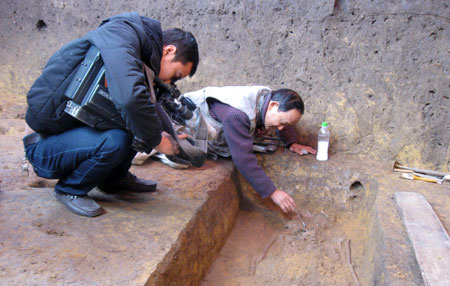Found the remains of ancient people 3,500 years ago
The remains were found at Dong Dau vestige in Yen Lac, Vinh Phuc was nearly intact, about 3500 years old and especially there were traces of black teeth dyeing and continued extraction of the front teeth of the upper jaw and jaw teeth. below.
Dong Dau archaeological site is located on Go Dau, in Dong Hai village, Vinh Mo commune, now Yen Lac town, Yen Lac district, Vinh Phuc province. This is an archaeological archaeological site typical of the prehistory of Vietnam, which was excavated 6 times with a total area of 758m by the Institute of Archeology, Museum of Vietnamese History and the History Department of the University of Social Sciences and Humanities - VNU Hanoi. 2 (in which, Archaeological Institute has excavated 3 times).
Most excavations found typical relics of 3 cultures: Phung Nguyen - Dong Dau - Go Mun are typical cultures of our nation that started the period of Hung Vuong to build the country. On April 21, 2000, Dong Dau was ranked by the State as a National-level Historical and Cultural Relic.
From December 11, 2012, the 7th excavation started with the participation of 3 agencies: Department of Archeology, History Department, University of Social Sciences and Humanities - VNU, Vietnam Archaeological Association and Vinh Phuc Department of Culture, Sports and Tourism. Phuc. Through 7 excavations, stone artifacts were discovered (axes, chisels, grinding wheels, rings, beads of jewelry), copper (axes, files, arrows, hooks, javelins), pottery (piece of pot , crumpled, pointed, pointed, ceramic balls and many tools of bone and horn, animal remains such as pig, deer, buffalo, cow, dog, tiger . and quite a lot of fish bones.
In 1999, the Vietnam Museum of History cooperated with Vinh Phuc Department of Culture, Sports and Tourism to conduct a sixth excavation that discovered a burial tomb, retaining the remains of Phung Nguyen culture.

The remains of thousands of years old remains quite intact.
This excavation, although only 25m 2 , but also discovered a tomb located at a depth of 3m, archaeologists have found the grave very clearly. The grave is almost intact except for the left thigh bone which is lost - probably because the next person digs a grave and does not rule out the damaging termite nest. The remains lie on their backs, their arms are stretched, the skull is broken, but the relatively hard remains can be restored even with the face bone. This is the skeleton of an adult, about 1.6 meters tall. The rough lower jaw bone, which has a jaw angle to the outside and the margin of the eye sockets, is characteristic of men. It is unclear for some reason, but the evidence of the right fibula is broken but it has resumed. In particular, there is a continuous dyeing of black teeth and continued extraction of incisors on the upper jaw and mandibular incisors.
The custom of extraction of teeth has been proved to only appear in burial sites of Phung Nguyen culture such as: Xom Roi (Phu Tho), Hang To II (Son La), Dinh Trang (Hanoi), some the tomb in Man Bac (Ninh Binh) and both tombs were discovered in Dong Dau.
The ancient human remains found in Dong Dau have the earliest date of about 3500 ± 110 ways today. These are extremely valuable evidence to learn about the human composition of ancient Vietnamese in the Red River basin. Finding the ancient human remains in Dong Dau will contribute to the scientific literature to clarify the problem of 'Vietnamese origin' - which many scientists are still trying to research and research.
According to Mr. Tran Van Quang - Director of Vinh Phuc Department of Culture and Tourism, this remains will be transferred to display at the General Museum of Vinh Phuc Province, to serve people and visitors at home and abroad.
- The skeleton is nearly two meters in the tomb of 5,000 years in China
- Dozens of remains in stone casket 1,600 years in Wales
- Rediscover the 6,500-year-old remains
- Mystery about ancient tombs for hundreds of years of remains in Nghe An
- Egyptian remains 3300 years with the ring
- Detecting ancient human remains 1.8 million years in Indonesia
- Found the ancient elephant remains that lived 3 million years ago
- Mexico studied 30 sets of ancient remains
- The erosion coast reveals six remains hundreds of years old
- The remains of the water tank reveal the collective beheading of the ancient book
- The shocking truth in the ancient tomb was found in Poland
- Graveyard for children more than 2,000 years in ancient China
 Discovered an ancient centipede fossil 99 million years old
Discovered an ancient centipede fossil 99 million years old Discovered bat-like dinosaurs in China
Discovered bat-like dinosaurs in China Discovered a 200-year-old bronze cannon of the coast
Discovered a 200-year-old bronze cannon of the coast Discover 305 million-year-old spider fossils
Discover 305 million-year-old spider fossils